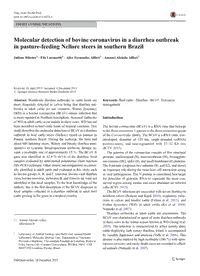
2016 Molecular detection of bovine coronavirus in a diarrhea outbreak in pasture-feeding Nellore steers in southern Braz PDF
Preview 2016 Molecular detection of bovine coronavirus in a diarrhea outbreak in pasture-feeding Nellore steers in southern Braz
SHORT COMMUNICATIONS Molecular detection of bovine coronavirus in a diarrhea outbreak in pasture-feeding Nellore steers in southern Brazil Juliane Ribeiro1 & Elis Lorenzetti1 & Alice Fernandes Alfieri1 & Amauri Alcindo Alfieri1 Received: 28 April 2015 /Accepted: 8 December 2015 # Springer Science+Business Media Dordrecht 2015 Abstract Worldwide diarrhea outbreaks in cattle herds are more frequently detected in calves being that diarrhea out- breaks in adult cattle are not common. Winter dysentery (WD) is a bovine coronavirus (BCoV) enteric infection that is more reported in Northern hemisphere. Seasonal outbreaks of WD in adult cattle occur mainly in dairy cows. WD has not been described in beef cattle herds of tropical countries. This study describes the molecular detection of BCoVin a diarrhea outbreak in beef cattle steers (Nellore) raised on pasture in Parana, southern Brazil. During the outbreak, the farm had about 600 fattening steers. Watery and bloody diarrhea unre- sponsive to systemic broad-spectrum antibiotic therapy re- veals a morbidity rate of approximately 15 %. The BCoV N gene was identified in 42.9 % (6/14) of the diarrheic fecal samples evaluated by semi-nested polymerase chain reaction (SN-PCR) technique. Other enteric microorganisms occasion- ally identified in adult cattle and evaluated in this study such as bovine groups A, B, and C rotavirus, bovine viral diarrhea virus, bovine torovirus, aichivirus B, and Eimeria sp. were not identified in the fecal samples. To the best knowledge of the authors, this is the first description of the BCoV diagnosis in fecal samples collected in a diarrhea outbreak in adult beef cattle grazing in the grass in a tropical country. Keywords Beef cattle . Diarrhea . BCoV . Extensive management Introduction The bovine coronavirus (BCoV) is a RNA virus that belongs to the Betacoronavirus 1 species in the Betacoronavirus genus of the Coronaviridae family. The BCoV is a RNA virus, non- enveloped, diameter of 120 nm, single-stranded (ssRNA) positive-sense, and non-segmented with 27–32 Kb size (ICTV 2015). The genome of the coronavirus consists of five structural proteins; nucleocapsid (N), transmembrane (M), hemaggluti- nin esterase (HE), spike (S), and small membrane (E) proteins. The S protein comprises two subunits (S1 and S2), and shows an important role during the virus-host cell interaction acting in viral pathogenesis. The N protein is considered best target for detection of genomic RNA to represent the most con- served region among strains and more abundant on infected cells (ICTV 2015). The BCoVinfections are associated with severe diarrhea in newborn calves (Boileau and Kapil 2010), respiratory infec- tions in calves and feedlot cattle (Fulton et al. 2013), and winter dysentery (WD) in adult cattle (Ko et al. 2006; Natsuaki et al. 2007). Diarrhea outbreaks in adult cattle are uncommon. The BCoV was characterized as agent of acute diarrhea outbreaks in dairy cows in the winter season known as WD (Jeong et al. 2005). The infection is characterized by affect mainly dairy cattle displaying dark watery diarrhea, which is accompanied by variable depression and anorexia (Valle et al. 2006). This disease is also marked by high morbidity (100 %) with spon- taneous recovery and rarely death cases are recorded in affect- ed animals (Natsuaki et al. 2007). * Amauri Alcindo Alfieri
